What Do People Listen
To at Work
New Study by Sonarworks Paints a Clearer Picture of Headphone Use in the Workplace
Download Report ↓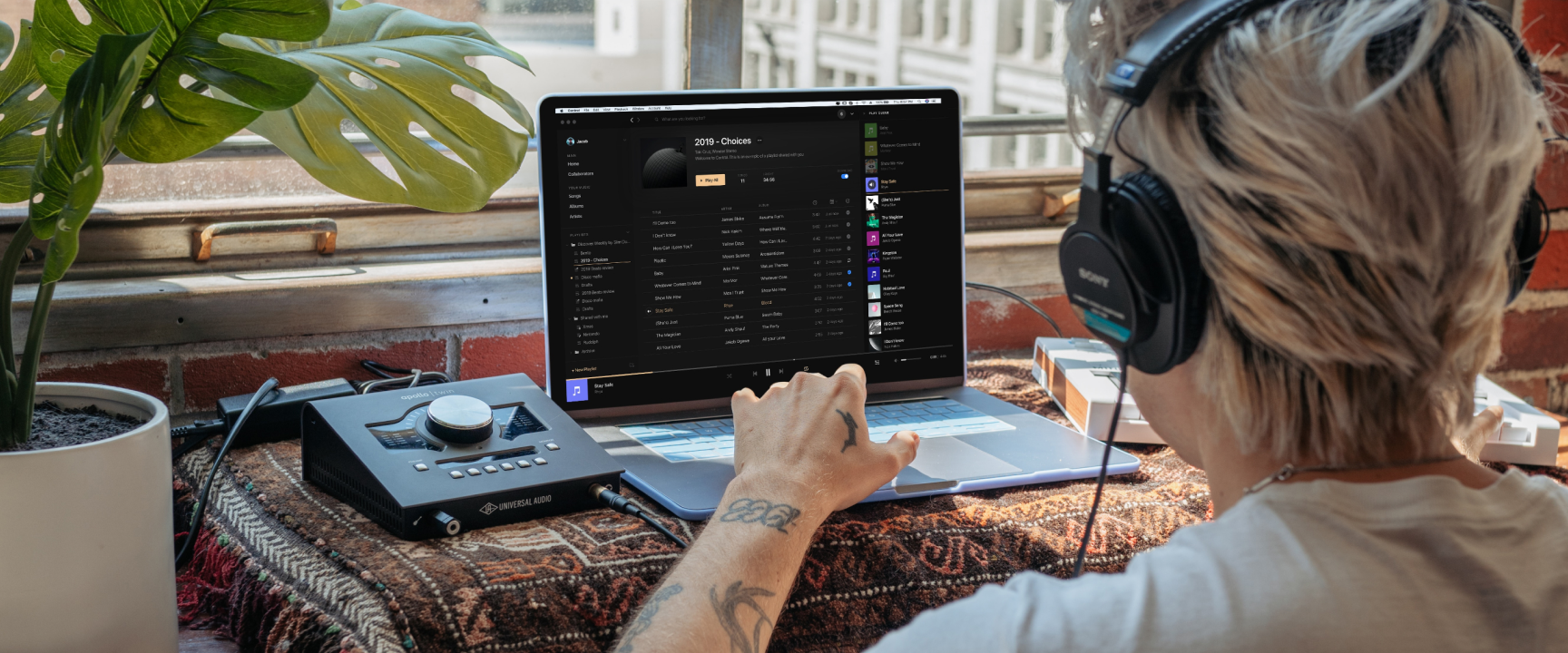
Perceptions surrounding headphone use have greatly changed over the years. In the past, it indicated a lack of focus on the job at hand. However, these days, using headphones in the office has become more commonplace. A survey by Sonarworks collected responses from employees who use a computer as part of their job, finding that 93.19% of those who do not require headphones for work wear them for personal reasons. While a little under 9% make it a priority to wear headphones while working, the majority of employees sometimes wear headphones and a third use them for most of their workday.
When it comes to audio content, music is the most popular choice among headphone users in the workplace, with approximately 41% of respondents choosing to listen to it. Podcasts and ambient or instrumental music follow at around 15%. According to the study, rock music is the most preferred genre for improving productivity and relieving stress at work, followed by pop music. Younger generations listen to comedy and entertaining content more often than older generations, with 26.9% of Gen Z stating that it slightly reduces their productivity.
While using headphones to increase productivity is not the top reason for wearing them, a little over 19% of employees wear headphones to block out distractions and improve focus. More than three-quarters of this group state that wearing headphones improves their productivity, either slightly or significantly. Others wear headphones for entertainment purposes, reducing stress or boosting their mood while working long hours. Sonarworks' study provides insight into why people wear headphones at work and how their choice of audio content affects their productivity.
Frequency of Headphone Use While Working,
By Reason and Generation
- 311 respondents 27.28%
- Work in an office space
- 406 respondents 35.61%
- Work remotely from home
- 423 respondents 37.11%
- have stated that they have a hybrid work schedule
Meanwhile, 423 people (37.11%) have stated that they have a hybrid work schedule. From this group, it was found that almost half, or 42.41% of employees, sometimes use their headphones several times a day for personal reasons, including for noise reduction or to improve their concentration.
The number of people who frequently used headphones for personal reasons is also significantly higher compared to those who rarely do so.
According to the study by Sonarworks, 24.51% of employees wear headphones for the most part of the day, while 8.75% of people shared that they make it a priority to wear headphones while working. This is in comparison to only 17.51% who occasionally wear headphones or wear them for a shorter period of time. Only 6.81% have shared that they prefer not wearing headphones while working.
Frequency of Headphone Use at Work
Frequency of Headphone Use While Working, By Reason and Generation
Always - I make it priority to wear
headphones during my working hours
Frequently - I wear headphones
for the most part of my working
Sometimes - I wear headphones
several times a day
Rarely - I wear headphones occasionally, or
for short periods of time
Never - I prefer not to wear
headphones while working
When it comes to the frequency of headphone use, a stark contrast can be found when looking at people by generation.
For instance, more Millennials and Gen Z employees tend to use headphones always or at least more frequently compared to those under the Baby Boomer and Gen X categories. The data also shows some differences between Millennials and Gen Zs in terms of headphone use frequency. The study found that more than 25% of Gen Z and almost 50% of Millennials always use headphones. Compared to less than 25% of Gen Z employees, close to 50% of Millennials frequently use headphones at work.
In contrast, more individuals from older generations rarely or never use headphones. Less than 25% of Baby Boomers rarely use headphones, while close to 25% of them never actually use headphones at work. Meanwhile, close to 50% of Gen X employees sometimes use headphones.
Headphones Used,
By Type and Generation

Headphones come in a variety of types, ranging from conventional earphones to Bluetooth or wireless headphones. The Sonarworks survey found that significantly more respondents (42.63%) preferred using over-ear headphones, including those with noise-cancelling features, at work. This is followed by 22.59% who opted to use wireless earbuds. On-ear headphones had slightly more users than in-ear or wired headphones, with 16.11% of users, compared to the latter’s 14.15% share.
The type of content people listen to can also be influenced by the type of headphones they’re wearing. Based on the study, 40.43% of headphone users say that the type of headphones they use influences what they listen to. More than 41% listen to music, followed by 15.39% who listen to either podcasts or ambient or instrumental music. On the other hand, 30.2% indicate that the type of headphones doesn’t play a role in the type of content they listen to.
Preferred Types of Headphones
Frequency of Headphone Use While Working, By Reason and Generation
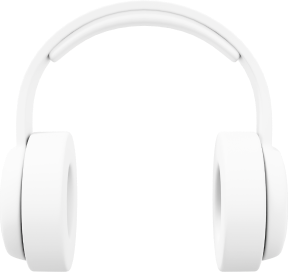
Including Noise Cancelling
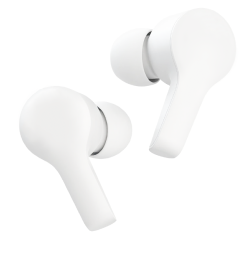
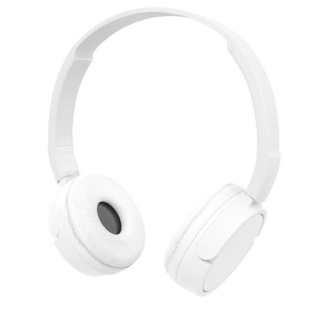
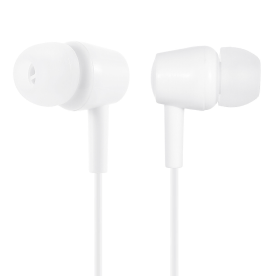
Including wired
What People Listen to While Wearing Headphones
When it comes to what people listen to while wearing headphones, the study found diverse options. Over 450 (41.53%) of people shared that they mostly listen to music. Podcasts and ambient or instrumental music have an almost equal number of listeners at approximately 175 (15%) each. This is followed by 99 (9.02%) people who prefer listening to lectures of educational content and over 50 (5%) people who said that they listened to audiobooks or comedy or other entertainment-related content.
Less than 50 (3.19%) people said that they listened to white noise or nature sounds, while even fewer people use headphones solely for noise cancellation. Close to 50% of Millennials listen to the following:
What Do People Listen To With Headphones While Working?
What People Listen to While Wearing Headphones
Instrumental Music
Educational
Entertainment
The study also found that almost 50% of Millennials and more than 25% of Gen Zs and Gen X employees don’t listen to anything while wearing headphones. According to them, they only use headphones for noise cancelling. Less than 25% of Baby Boomers listen to each category. However, more Baby Boomers prefer listening to music, lectures or educational content, and ambient or instrumental music while wearing headphones.
Preferred Music Genres, By Generation
A person’s music preferences are determined by factors like personality and biographic variables. While a person’s musical identity is shaped during their adolescence, preference may be subject to change over time. It can also be influenced by how they perceive the artists they’re listening to, preferring to listen to artists who they can identify with. A person’s age, traits, and gender can also influence their musical preferences.
The type of music a person listens to can either have a negative or positive impact on their productivity, depending on their preference. For instance, listening to music that’s preferred by the listener can temporarily give their cognitive performance a boost. However, there are some who will find music distracting.
TOP-10 Preferred Music Genres
What music genres employees prefer to listen to when working?
According to the Sonarworks study, rock is the most popular music genre among Baby Boomers, having a 10% share, compared to other genres like jazz (8.1%), pop (7.4%), and classical (7.3%).
The least popular genres for this age group are the following:
- Punk Rock 2.9%
- EDM 2.7%
- Latin Music 2.5%
- Heavy Metal 2.5%
Gen Xs share the same top four genres as Baby Boomers, with rock taking the number one spot, being preferred by 9.5% of headphone users. This is followed by 7.3% of people who prefer to listen to pop music, 6.3% who listen to jazz, and 5.9% who choose to listen to classical music. The least popular genres for Generation X are:
- Psychedelic rock and reggae, with each preferred by 3.2% of listeners
- Disco and punk rock, with each preferred by only 2.9% of listeners
More Millennials listen to rock (8.1%), compared to pop (6.5%). While 5.4% and 5.1% listen to hip-hop/
8.6% of younger listeners prefer listening to pop, while 7.8% of Gen Z people opt to listen to hip-
The type of content people listen to can also affect their productivity. Approximately 41% of employees indicated that listening to audio content significantly improves their productivity, helping them stay focused and become more efficient. Close to 34% say that listening to content using headphones only slightly improves their productivity, allowing them to stay on track with tasks. Note that for this group, their productivity is improved only to a small extent. A little over 17% say that doing so has no impact on their productivity, stating that listening to content using headphones neither increases or hinders their productivity at work.
Aside from listening to content to boost productivity, using headphones while working also helps approximately 15% of workers improve their mood and relieve stress. This is followed by over 13% who say that doing so helps reduce stress and induce relaxation. Furthermore, around 9% say that listening to content on their headphones allows them to create a calming or peaceful environment.
The study also surveyed individuals who don’t work in an office—workers who have a hybrid or remote setup or whose job responsibilities don’t require them to work on the computer or at a desk—including 51.8% of people who are not required to wear headphones as part of their job.

Main Reason for Wearing Headphones While Working
Why do people wear headphones while at work?
According to the Sonarworks study, what people listen to while wearing headphones depends on what their goals are. However, while wearing headphones can be beneficial, listening to loud music for too long can have negative repercussions. According to the World Health Organization, prolonged exposure to loud sounds can cause fatigue to the ears’ sensory cells, which are primarily responsible for helping people hear.
Temporary exposure to loud noise can cause tinnitus, which is a buzzing or ringing in the ears. This feeling will improve with time once the sensory cells start to recover. However, regular or prolonged exposure to loud noise can lead to permanent damage to the sensory cells, which, in turn, can lead to noise-induced hearing loss.
Exposure time guidelines indicate that for every 3 dBAs over 85 dBA, permissible exposure time before any permanent damage occurs is halved. Following the WHO guidelines to minimize the risk of hearing damage, it is recommended that people listen to music or other audio content on their headphones at a volume that’s below 60% of the maximum. WHO also suggests using noise-canceling headphones, as well as limiting exposure to loud noises after work. Additionally, using an app to monitor sound levels can help.
Improve Productivity
For some, wearing headphones and listening to music can help boost their productivity. Music affects broad networks of the brain. According to a Harvard Health Publishing article, music not only affect the brain’s auditory cortex, but it also activates different parts of the brain responsible for emotion, memory, and even its motor system.
Based on the survey findings, people who are not required to work on a computer and listen to headphones as part of their job still opt to wear headphones while working to increase productivity. Furthermore, there is a link between the type of music they listen to and the outcomes they get. For instance, 53.24% of the surveyed listen to music to increase productivity. This is followed by 12.50% who listen to ambient or instrumental music and 8.33% who listen to podcasts.
When it comes to the type of music people listen to boost their productivity, rock comes out as number one, being preferred by 8.99% of respondents. Pop is the second most popular genre among this group, being preferred by 8.61%. Other popular music choices include jazz (5.74%), R&B and classical (5.49% each), funk and hip-hop/rap (5.37% each), and ambient (4.99%).
Learn New Things, Block Out Distractions, and Reduce Stress
For others, listening to a specific type of audio content, such as podcasts, allows them to learn new things or stay up-to-date with the latest news. There are also those who want to block out distractions and improve their focus and, thus, listen to white noise or nature sounds. Some want to reduce stress or create a peaceful environment, which is why they prefer tuning in to ASMR, humorous content, or ambient music.
Individuals who are working in an office or at a desk but are not required to wear headphones for work, the study also found interesting correlations when it comes to employees’ main reason for wearing headphones while working. Based on the data, these individuals wear headphones to reduce stress, induce relaxation, create a calming or peaceful environment, and improve their mood. Moreover, the type of music they listen to also influences the outcome, with rock being the most popular type of music being listened to by 8.59% of people to reduce stress. Other popular genres that help listeners reduce stress and improve their mood include pop (7.36%), jazz (6.13%), hip-
Main Reasons Why People Use Headphones at Work
Approximately 19% of respondents indicated that they wear headphones to block out distractions and improve their focus. This is followed by around 16% of respondents who said their main reason for wearing headphones while working is to entertain themselves, especially during long work periods. For another group, wearing headphones helps improve their mood and relieve stress.
Based on the study, increasing productivity isn’t the number one reason for people wearing headphones, given that only around 13% of respondents identified that reason. Reducing stress and inducing relaxation, meanwhile, is the main reason why 13.49% of respondents wear headphones while working.
Why People Use Headphones at Work?
Main Reasons Why People Use Headphones at Work
Using Headphones vs. Productivity
Significantly improves productivity - listening to content in my headphones helps me stay focused and work more efficiently
211 (41.70%)
Slightly improves productivity - listening to content in my headphones can help me stay on task and be more productive, but only to a small extent
173 (34.19%)
No impact on productivity - listening to content in my headphones neither helps not hinders my productivity at work
88 (17.39%)
Slightly reduces productivity - listening to content in my headphones can some-times distract me on my work & make me less productive, but only to a small extent
25 (4.25%)
Significantly reduces productivity - listening to content in my headphones is a major distraction that negatively impacts my productivity at work
9 (1.78%)
Less than 10% of people cited that their main reason for doing so was to create a calming or peaceful environment or to learn new things.
Aside from filtering out distractions and recreating an ideal environment while at work, wearing headphones can serve as a signal to others that the wearer is busy working and shouldn’t be disturbed. The study shows that wearing headphones can be beneficial.

Reasons Why People Use Headphones, By Generation
Looking at the findings from a generational standpoint, approximately 50% of Millennials and more than 25% of Gen Xers wear headphones to increase productivity, compared to less than 25% of Gen Zs and Baby Boomers. More Millennials, close to 50%, use headphones to learn new things and self-educate. This is followed closely by around 25% of Gen Xers, Gen Zs, and lastly, Baby Boomers.
In the rest of the categories, close to 50% of Millennials wear headphones while working to eliminate distractions and improve their focus, entertain themselves, reduce stress, create a peaceful environment, and improve their moods. They’re followed by more or less 25% of Gen Xers who share the same sentiments. Based on the findings, less than 25% of Baby Boomers and Gen Z employees use headphones to achieve the aforementioned goals.
The Effect of Listening to Content on Productivity at Work
Listening to audio content, such as podcasts–which around 15% of employees do–at work can help employees learn new things and stay motivated. However, it does have some drawbacks. Because podcasts have the ability to capture their audience’s attention, listening to them while at work can cause distractions, which, in turn, can adversely affect productivity.
Contrary to popular belief, listening to content while at work has little to no effect on workers’ productivity. As evidenced by the Sonarworks study, listening to content on headphones can significantly improve productivity. According to almost 220 (41.7%) people, listening to content using their headphones allows them to stay focused and work more efficiently. The type of content people listen to also plays a role in whether or not it can boost or hinder their productivity. Listening to white noise or ambient sounds allows them to block out distractions and improve their focus, which is something that approximately 19% of employees do. Furthermore, approximately 13% of employees listen to music to increase their productivity.
Meanwhile, less than 180 (34.19%) people have noted that listening to content slightly improves their productivity—yes, it helps them focus on the task and become more productive but only to a lesser extent.
On the other hand, a little over 80 (17.39%) people have indicated that listening to content neither helps nor hinders their productivity at work. In contrast to the positive impact of listening to content on productivity, only a little over 20 (4.94%) people shared that doing so makes them less productive to a small extent, while less than 20 (1.78%) have noted that listening to content significantly reduces their productivity at work.
Examining the data from a generational standpoint, close to 25% of Baby Boomers have noted that listening to content significantly reduces their productivity. This is followed by an almost equal number of people from the same generation who said that doing so has no impact on their productivity levels. Noticeably fewer Baby Boomers consider listening to content as having a significant positive effect on their productivity at work.
This is in contrast to the percentage of Gen Xers and Millennials who believe that listening to content helps boost their productivity. Close to 50% of Millennials and more than 25% of Gen Xers believe this to be the case. However, it’s also worth noting that approximately 50% of Millennials believe that this activity significantly adversely impacts their productivity. In addition to that, over 25% of Gen Z employees believe that listening to content using their headphones slightly reduces their productivity.
Going back to data collected, the type of music the employees listen to influences their productivity at work. For instance, those who listen to rock music, or around 8% of people, note that doing so significantly improves their productivity, allowing them to stay focused and work more efficiently. Other popular music genres that play a significant role in improving people’s productivity levels at work include pop (6.92%), jazz (5.42%), hip-hop and rap (5.29%), classical (5.11%), R&B (5%), and ambient music (4.81%).
Summary
The study by Sonarworks reveals some interesting insights into headphone usage among employees. It finds that 93.19% of people use headphones in the workplace for personal reasons. How often they wear headphones while working varies. For instance, nearly a third (24.51%) wear headphones for the most part of their workday. Almost a tenth (8.75%) prioritize wearing headphones while working on their tasks. Meanwhile, Millennials and Gen Zs are more likely to always wear headphones in the workplace than Gen X and Baby Boomers.
The type of content that people listen to while wearing headphones also differs. Music (41.53%) tops the list of what people listen to while working. This is followed by ambient or instrumental music (15.39%) and podcasts (15.21%). When it comes to which genre of music is most popular, the majority (8.99%) prefer listening to rock music to increase their productivity. Most people (8.59%) also listen to rock music to boost their mood and reduce stress.
In addition, the Sonarworks study uncovers several reasons why employees wear headphones in the workplace. The number one reason is blocking out distractions and improving employees’ focus (19.89%). For this group, wearing headphones either significantly improves (43.4%) or slightly boosts (33.96%) their productivity while working.
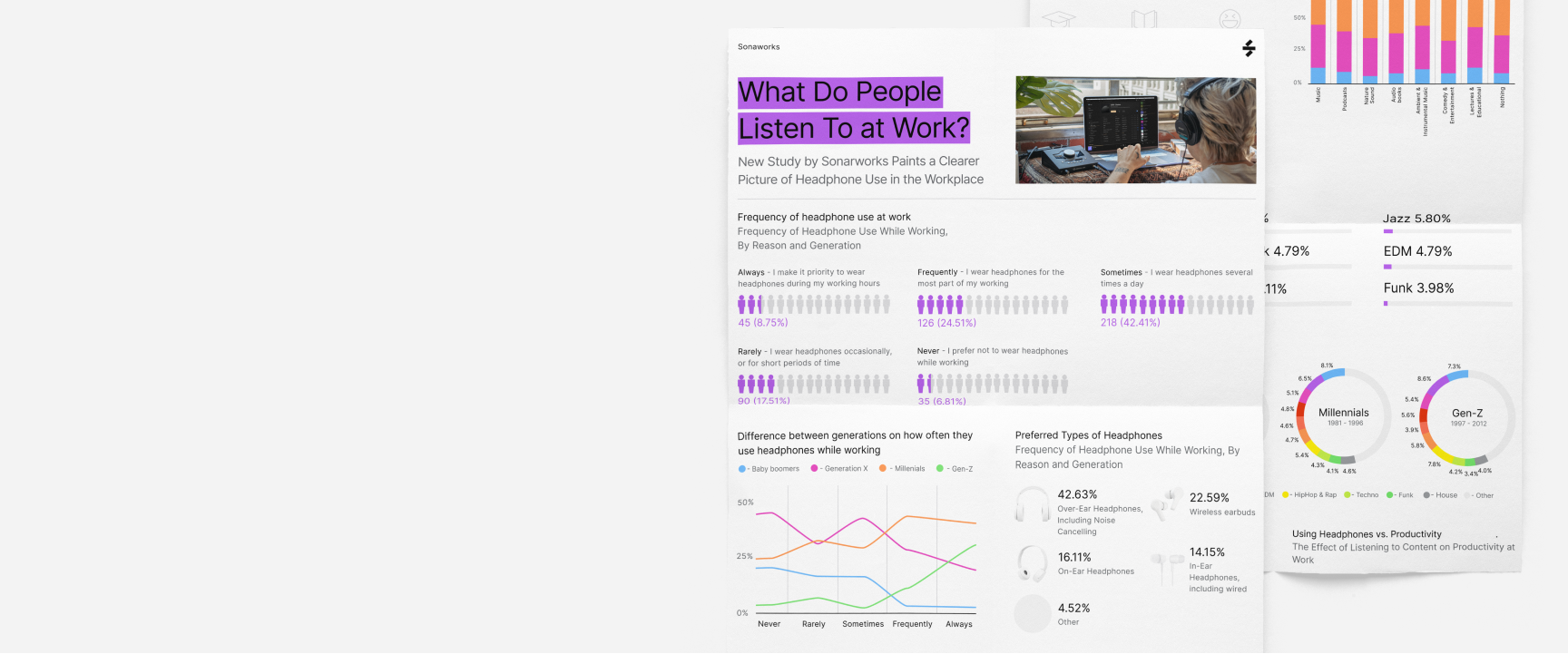
Download Report PDF
Methodology
The findings in the study are based on a Sonarwork's survey conducted between 21st and 31st March 2023. The survey was distributed through their email database and relevant social media channels including Reddit and LinkedIn. The survey targeted individuals who were currently employed in office, work-from-home or hybrid settings, and whose job responsibilities did not require the use of headphones, such as in call centers. The survey received 1140 qualified responses from individuals aged between 18 and 76, residing in the USA, Europe, and the UK.
References
-
-> https://www.grandviewresearch.com/industry-analysis/earphone-and
-headphone-market#:~:text=Report%20Overview,12.6%25%20from%202023%20to%202030. - -> https://blog.landr.com/types-of-headphones/
-
-> https://www.sciencedirect.com/science/article/
abs/pii/ S0092656617300107#:~:text=Music%20genre%20preference%20measures%20the, %2C%20happy%2C%20or%20relaxing). - -> https://psycnet.apa.org/doiLanding?doi=10.1037%2Fpspp0000397
- -> https://psycnet.apa.org/doiLanding?doi=10.1037%2Fpspp0000397
-
-> https://www.noisyplanet.nidcd.nih.gov/parents/
what-is-noise-induced-hearing-loss - -> https://osteopathic.org/what-is-osteopathic-medicine/headphones-hearing-loss/
- -> https://today.ucsd.edu/story/a-voice-inside-my-head-the-persuasive-power-headphones-have-over-speakers
- -> https://podcastrocket.net/listen-to-podcasts-at-work/
- -> https://work.chron.com/safety-use-personal-headsets-workplace-12035.html
- -> https://www.flexjobs.com/blog/post/surprising-results-about-wearing-headphones-at-work-productivity/
- -> https://www.inc.com/scott-mautz/this-is-what-people-think-of-you-when-you-wear-headphones-at-work-according-to-an-800-person-study.html
-
-> https://www.hcamag.com/au/news/general/
wearing-headphones-at-work-time-for-hr-to-step-in/154033 -
-> https://www.washingtonpost.com/
science/2022/09/25/music-taste-personality-traits/ -
-> https://www.ncbi.nlm.nih.gov/pmc/articles/
PMC3138530/ - -> https://www.indeed.com/career-advice/career-development/listen-to-music-at-work
- -> https://hrnews.co.uk/is-it-professional-to-wear-headphones-at-work/
-
-> https://www.komando.com/small-business/
wearing-headphones-in-the-office-can-yield-a-surprising-boost-in-productivity/529309/ - -> https://www.svg.com/232677/when-you-wear-headphones-all-day-this-is-what-happens-to-your-body/
-
-> https://www.cdc.gov/nceh/hearing_loss/
how_do_i_know_if_i_have_hearing_loss.html - -> https://www.health.harvard.edu/blog/why-is-music-good-for-the-brain-2020100721062
- -> https://www.businessnewsdaily.com/11294-music-effect-on-productivity.html
- -> https://www.webfx.com/blog/internet/music-productivity-infographic/
-
-> https://www.hopkinsmedicine.org/health/
wellness-and-prevention/keep-your-brain-young-with-music
Fair use statement
We’d love for you to share our findings for non-commercial purposes. All we ask if you include our findings in your own articles or coverage is that you link back to this page to give credit to sonarworks.com.